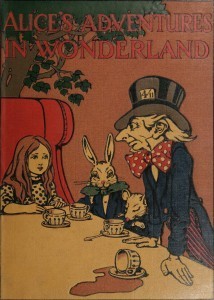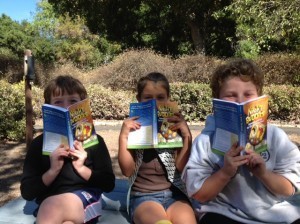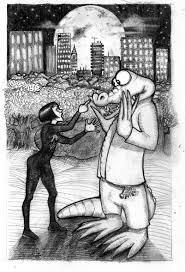Sands Hetherington's Blog, page 20
September 23, 2014
Make Your Very Own Whatchamacallit!
Whatchamacallit: A small object having a special power and suitable for hanging on Crosley’s belt.
If you’ve read the Night Buddies series, you would already know this definition. Crosley’s whatchamacallits are some of the most important things he and John need to be able to make it through their Programs. And if you’ve ever wished you had a belt full of whatchamacallits yourself, we’ve got a list here of some ways that you can go about making them at home!
I-ain’t-here doodad: The very first whatchamacallit that Crosley ever uses in the series, this is probably one of the most important whatchamacallits there is. To make your own, buy a small, round magnifying glass. Don’t forget to hold it up in front of you when you need to disappear!
I-D gimcrack: This whatchamacallit not only identifies Crosley as a member of Night Buddies Amalgamated, but works just the same as money. To make your own, draw one that looks like Crosley’s, and glue in a photo of yourself so that you can be correctly identified. If you want it to look really official, laminate both sides.
Rope gizmo: John and Crolsey use this whatchamacallit in Book One (Night Buddies and the Pineapple Cheesecake Scare) to lower themselves down into a hole so that they can stop the Iguana gang. To make your own, find a small rubber ball and attach several inches of clothesline to it. You could also attach jump rope, string, shoe laces, or anything else that can work like rope if you don’t have any clothesline!
Trap-spinner loblolly: This whatchamacallit looks like a spider, and acts like one too as it shoots off web-like wire! To make your own, get a rubber spider and attach black pipe-cleaners to its mouth loosely. When you need to activate the whatchamacallit, let the pipe-cleaners come loose!
Time-spreader dingus: This whatchamacallit slows down time so that John doesn’t get into any trouble for being out so long on Programs! To make your own, acquire a very small telescope, or a pen light. If you pull it open (without breaking or damaging it) you’ll be using it just like Crosley does to help John!
Skeleton key: This is the key Crosley uses to open John’s front door. To make your own, you can use any large, old-fashioned brass or iron door key. Decorate it however you think Crosley would like it best!
Do you have a favorite whatchamacallit or have you ever made your own? If so, let us know all about it in the comments!





 *protected email*
*protected email*
September 16, 2014
Drawing Inspiration: Why Favorite Quotes Are Important for Authors
An author’s favorite writers can often say quite a bit about where they draw inspiration for their own novels from. For instance, the Night Buddies books are full of imaginative descriptions and witty dialogue, which could be why one of Ol’ Sands’ favorite quotes comes from Lewis Carroll’s Alice’s Adventures in Wonderland: “‘And what is the use of a book’ thought Alice, ‘without pictures or conversation?’”
If you want to learn more about our favorite author, take a look at some of these quotes that Ol’ Sands has declared his favorites.
“A little nonsense now and then, is cherished by the wisest men.” Roald Dahl, Charlie and the Great Glass Elevator
“Those who don’t believe in magic will never find it.” Roald Dahl
“He wrapped himself in quotations – as a beggar would enfold himself in the purple of Emperors.” Rudyard Kipling, Many Inventions
“If you pick up a starving dog and make him prosperous, he will not bite you. This is the principal difference between a dog and man.” Mark Twain
“I hate writing, I love having written.” Dorothy Parker
We’re glad you’ve written too, Ol’ Sands!
All of these quotes have come directly from author Sands Hetherington’s Goodreads page. Make sure you go out and add him as a friend so you can keep updated with all of his favorite quotes, current reads, and of course, information about the Night Buddies series!
http://www.goodreads.com/author/show/...





 *protected email*
*protected email*
September 10, 2014
What Makes Good Children’s Fiction?
Writing a book that children will fall in love with at a young age is an important goal for many reasons, the most important of which is that one good book can turn a child into a reader for life. Do you remember your favorite book as a kid? Ol’ Sands does. When asked in an interview what his favorite book as a child was, he answered, “The OZ series. Critics said Frank Baum had no literary merit, and I understand what they meant, but kids weren’t interested in literary merit. They knew what they liked, and that guy had a captivating imagination if anybody ever did.”
So that brings us to the question, what makes a good children’s book? Should it possess the same qualities of adult literature? What makes it special?
If you’re an aspiring author or simply someone who loves juvenile fiction, and you’re trying to answer these questions yourself, here are some of the answers that we have found.
The more imagination used, the better. Kids love to use their imagination, and their favorite books tend to take their imaginations to new levels. Think about the most popular children’s books—Harry Potter, Where the Wild Things Are, even the Oz series—they all use enormous amounts of imagination, and kids remember them for life.
Strong, memorable characters. Children’s fiction is not the place to play around with unlikeable, complex characterization. You need a hero, and you need a hero that your young readers will want to be best friends with. In Night Buddies, John is the character that kids relate to, but Crosley is the one that stands out to them, because they want to be his best friend too!
There must be a lesson. Good children’s books don’t need to end with a cheesy, “And this is what he learned,” line, but they do need to offer kids insight into some kind of moral or life lesson that they are still trying to grasp in their lives. We go to books to understand something about the world we live in, whether we are reading as children or adults, and it is important that children get this from the very first books they read.
If you’re a writer, try incorporating these tips into your own stories and see how it goes. Let us know if you have any other answers to the question, “What makes a good children’s book?” in the comments!





 *protected email*
*protected email*
September 2, 2014
Want a Reason to Pick Up a Night Buddies Book? Just Ask These Kids!
Not only have the Night Buddies books won six awards amongst the literary community, but when Ol’ Sands went to visit Mrs. Miles’ third grade classroom this is what he heard:
“I think your book is the greatest. It used a lot of imagination. Crosley is the funnyst crocodile. Yerk, yerk, yerk!” –Nick
“I liked all the funny things Crosley had, like the I-ain’t-here doodad, whatchamacallit, and the way he laughed, yerk, yerk, yerk!” –Maria
“I want your book to be a passer! A passer is something that if I have children I can give it to my children. And if my children have children they can give it to their children. And that’s what I call a passer.” –Jaime
“I really liked Night Buddies! I thought it was the best story in the world! My favorite part was the part that Crosley started doing the Black Bottom!” –Mary
“Night Buddies was the greatest book I’ve ever read. Especially Crosley’s I-ain’t-here doodad, and when Crosley got wet and did the Black Bottom dance. I’ve been writing a story about the iguanas or should I say jerks.” –Stacy
“I especially like the I-ain’t-here doodad. You are a really good author!” –Heather
“The story was great I am not lying to you. It was great. I loved it. I loved the whole thing.” –Rick
So there you have it! Don’t take our word for it that your children will love the Night Buddies series, but take it straight from their peers themselves. (After all, Rick was not lying to you.)
And a big congratulations to Ol’ Sands! Night Buddies, Impostors, and One Far-Out Flying Machine was recently announced as a bronze winner in the Global eBook Awards.





 *protected email*
*protected email*
August 26, 2014
Do You Have What It Takes To Be a Night Buddy?
There are certain characteristics that make a person stand out to be a qualified Night Buddy. Take a look at this list and see if you have what it takes!
1.) Patience—Every Night Buddy must have the patience to endure Crosley’s insatiable appetite for Pineapple Cheesecakes, to wait for his Black Bottom dance fits to come to an end, and to make it through a night without sleep. Every challenge that confronts the Night Buddies in their Programs are best overcome one step at a time; you can’t sneak out of the house before you’ve turned on your I-ain’t-here doodad!
2.) Kindness—Night Buddies will meet a whole world of new people and animals on their first Program, and they need to treat each one of them kindly and respectfully in order to complete their adventure. If you aren’t nice to Fast Fanny Farnsworth, you can’t expect her to rent you a far-out flying machine!
3.) Bravery—Sometimes the tasks that Night Buddies take on seem a little scary at first. After all, iguanas are not creatures that you really want to be around! But Night Buddies know that no matter how scary their Program might seem at first, they can step up and face what lies ahead with bravery. Someone has to keep the iguanas in their place!
4.) Imagination—Some people think that being a Night Buddy is something that only happens in books, but true Night Buddies know that imagination is what makes stories come to life. You can use your patience, kindness, and bravery when you’re at school or playing at home with your siblings, whether you have Crosley by your side or not, because when you use your imagination you can be on a Program anytime!





 *protected email*
*protected email*
August 19, 2014
Top 5 Reasons Crocodiles Are Even Cooler Than You Thought!
We all know that Crosley the Crocodile is pretty awesome, what with his out-of-this-world appetite for Pineapple Cheesecakes and his impeccable Black Bottom dance skills, but did you know just how cool all crocodiles can be? Here are some reasons why Crosley thinks it’s cool to be a crocodile.
1.) Crocodiles can be found all around the world! They live in the tropics of North and South America, Asia, Africa, and Australia. This makes them different from alligators, which are only found in parts of the United States and China.
2.) Crocodiles have a similar lifespan to humans. They usually live anywhere from seventy to one hundred years! The Nile crocodile tends to live longer, making it closer to one hundred years in age, while the Saltwater crocodile usually lives to about seventy years old.
3.) Saltwater crocodiles are the largest species of crocodile, and is the largest reptilian predator in the world. The males can end up being twenty-two feet long, and almost 4400 pounds! On average, though, they end up being around seventeen feet long and two thousand pounds, which is still quite a bit bigger than any of us!
4.) Crocodiles have the strongest bite of any animal in the world. Despite this, however, the muscles that open the crocodile’s jaws are not very powerful. A strong person could hold a crocodile’s mouth closed with their bare hands!
5.) Crocodiles really do cry! Tears are normally only noticeable if the crocodile has been out of the water for a long time and the eyes begin to dry out, they don’t cry from emotion like people do.
Despite being one of the coolest species (or at least Crosley thinks so), just make sure you don’t try to befriend a crocodile in the wild. The only ones humans should be playing with are the ones that show up with a Night Buddies adventure to complete!





 *protected email*
*protected email*
August 12, 2014
Rescuing Bedtime Stories: 4 Ways to Create Stories When You’re Storied Out
Sharing bedtime stories with your child is an important night-time ritual for many parents. In fact, research has shown that children of parents who have bedtime stories show increased brain activity, particularly vocabulary and logic skills. Those skills will serve as the foundation for a better reader for the rest of their life. Bedtime stories also deepen your relationship with your kids and help to establish a bedtime routine (something every parent needs for their child). It’s also a time for both parents and children to wind down for the day.
Having said that, coming up with a bedtime story for your child EVERY night can be a little overwhelming. You can only read the same books so many times before your child gets bored. You can only talk about the same characters (princesses and superheroes) for so long.
So what do you do when your child asks for a story and your mind goes blank?
1. Put your child in the story.
Whether it’s princesses or superheroes (or superhero princesses), allowing your child the opportunity to be in the story stretches their thinking muscles and enhances their linguistic skills. It also gives the chance to develop and enhance another muscle, their imagination.
2. If you are reading a book, ask them, “What do you think happens next?”
3. Put your child in the storyteller’s seat. Ask them to tell you their favorite story.
Asking your child to retell a story back to you gives you (the master storyteller) a break. In addition to allowing them to practice another important skill, memory. Because children (actually everyone) remembers what they believe is important, allowing your child to tell the story gives you a front row seat into what your child values.
4. Take an old story and add a unique spin to it.
This is an old trick that people ranging from writers to Disney use. Take an old story that everyone knows like “Red Riding Hood” and re-imagine it. What is Red Riding Hood could fly? What if Jack didn’t climb the beanstalk, choosing to take the elevator?
The point of these suggestions is to make storytelling fun and interactive. Storytime should not be a tired old routine that you do because you have to. Storytime should be an important time for your child to relax and develop the skills that will serve them in their lifetime.





 *protected email*
*protected email*
August 5, 2014
Why You Should Be a Reading Superhero for Your Kids (and how to do it!) Guest Post by Charles Franklin
Reading is a skill that every parent knows is essential for their child to thrive in the modern world. Gaining your children exposed to reading helps foster brain development, language development, and more at a critical time in their development. The skills and behaviors learned in those early years can have a strong impact on your child throughout their life. Starting early helps build a foundation that your child can improve on in the later years. In other words, the earlier, the better!
Gaining reading skills is such an important task that pediatricians now offer reading as a prescription for children as well as their parents (for their newborns). Not gaining these skills can be detrimental. According to an article from Quello.com, children with parents who read to them an hour a day had a vocabulary of 10,000 words of more by the time they reached Kindergarten! Low literacy can also impact children as they get older. According to Intellihealth.com, surveys show that children who don’t develop the appropriate reading levels by third grade harve a harder time graduating from high school. Adult patients with low literacy had more problems with their treatment and medication compared to those with well-developed literacy.
Children often begin their path to reading in Kindergarten, but that path can (and should) begin earlier than that. The more exposure your child has to reading, the easier reading can become for them. The earlier you expose your child to reading, the better. It can begin at home, with you. Sadly, a survey found that only half of parents with young children read to their children every day (see here). We can improve that!
You can be a reading superhero. A reading superhero is a parent or other adult who demonstrates and shares their love of reading with children so they can battle for literacy!
All it takes is a minimum of 15 minutes…
Here’s how you can get started….
1. Read to your kids every day (even if it’s just 15 minutes a day!)
Reading to your kids every day sets the foundation for reading behavior in the future. Depending on your child’s age, this can range from just a few minutes reading aloud and allowing a child to play with a book or can be a 30-minute (or more) dedicated storytime. Find the time and balance that works right for you and your family.
2. Have a dedicated time and place to read.
One way to encourage a habit is to repeat a behavior in the same place at the same time. Reading to your children in a comfy chair or by their bedside consistently helps children starts the process. After awhile, children will expect to have a book when they get in that chair (even if you aren’t there with them!).
Don’t worry though if your child wants to read a book at a different time or in a different location. Reading is reading! The point is to establish the behavior.
Choose a comfortable, quiet spot and start reading!
3. Keep books and magazines around the house.
Another easy way to encourage literacy is to have books and magazines around the house. Buy a couple of children’s books (based on your child’s interests) and magazines to keep your child busy. Encourage them to read when they feel bored. Develop activities and stories based on the books you read (Sands Hetherington did this and became a 6-time award -winning author!)
All it takes two or three books to start.
4. Encourage and praise reading behaviors.
Talk about reading and encourage reading in your home! When your child finishes a book, ask them about it. Ask them to read the book to you and others (like siblings or their favorite teddy bear). Get them in habit of seeing reading as a natural and positive activity in your house. Your child will follow suit.
5. Read yourself!
Children model what they see. If they see that you as a parent enjoy and make time for reading. They will model that behavior
You’ve got your orders. Now go out and start reading!
Need more help? Check out these additional tips and resources:
“Born to Read” (Insight on how to read your child) http://www.human.cornell.edu/pam/outr...
“Importance of Reading” http://www.mychildrensmedicaid.org/co...
“Born to Read” http://www.ala.org/alsc/issuesadv/bor...
“Reach Out and Read Program (Physician-led literacy program for kids): http://www.reachoutandread.org/
“Babie





 *protected email*
*protected email*
July 29, 2014
Eleanor Roosevelt and Me!
I was very nearly six when Eleanor Roosevelt came and stayed the night with us, at my grandmother’s where my mother and I lived. Our house was right next to a big army camp in Greensboro, NC. My grandmother was an education honcho, a hands-on trustee at two colleges at least, and director of the city U.S.O. One of the colleges was Bennett, a school across town for black girls. It still takes only black girls, and is virtually unique this way. Mrs. Roosevelt was giving a speech there, and it was only proper and right that she stay at my grandmother’s.
My memories of it all are fairly sketchy, because I was a shy little kid, and there was a terrible lot of bustle and fuss. I pretty much stayed away.
I remember silent men in suits standing along the edges of the front yard. I played outside a lot to avoid the goings-on in the house, but I really avoided those guys!
I only saw her once. She came along our driveway in a big car to go on a tour of the local black colleges, and I was out there in the yard. Before I could run and hide, the car slid alongside and Mrs. Roosevelt rolled her window down and gave me the nicest wave and smiled big with those wonderful teeth of hers. I really wish I had waved back, but I’m sure I just stood there.
That night she told the grownups she’d like to meet the little boy of the house. She was really nice, just like you hear. Gracious to me, even. Part of our family lore has my mother finding me and saying, “Mrs. Roosevelt wants to meet you!” That scared me good and proper and I shot back, “I done seen her.” Which was true. I can’t believe I snubbed Eleanor Roosevelt. But I’m sure she understood.
The Roosevelts were very wealthy, everybody knows that. Not to mention accomplished. But Eleanor was a Democrat to the bone, with no airs or affectations. After she left, my grandmother’s maid announced proudly to my grandmother, “You got better stockin’s than she does!”
She had three weeks remaining to be First Lady.
Note: That’s the two of them in the picture in front of some of my grandmother’s books. Miss Laura (my grandmother) was a natural speed-reader. She had over 3,000 great books, had read them all, and gave away at least 5,000 more when she was through with them. Some of them are in my personal library today, which I’m very grateful for.





 *protected email*
*protected email*
July 22, 2014
Creating a Night Buddies Adventure Story — Sands’s Writing Process
People often ask me about the writing life, what’s my process when writing a new Night Buddies adventure story.
The main thing for me is scheduling and dedication. I make a schedule and stick to it no matter what happens or how rotten I may feel that day. I don’t go for anything like eight hours. I doubt many writers do that. It’s just too exhausting. Three hours does it for me, but I try never to stint on my three hours.
I try to stop writing at a spot that will be easy to start from the next day. And to read everything I’ve got the next day before starting again, so everything will be of a piece, so to speak.
I like to do about five hundred words a day and do it straight through. I get in trouble when I start trying to do a line at a time, that is, getting a line just so before going on to the next one. This hurts my flow (from the reader’s point-of-view) and wastes time. I try to do my five hundred words without looking back, and then take fifteen or twenty minutes to clean it up.
If I get stuck, I take a little notepad or recorder and go for a walk.
I finish the whole business and then rewrite and rewrite. I need to stop this at some point, but I try to err on overdoing it.
So this is what works for me. You’re welcome to try it out. Don’t forget to let me know if you’ve got any great tips on what to do when getting stuck. I’d love to hear!





 *protected email*
*protected email*










